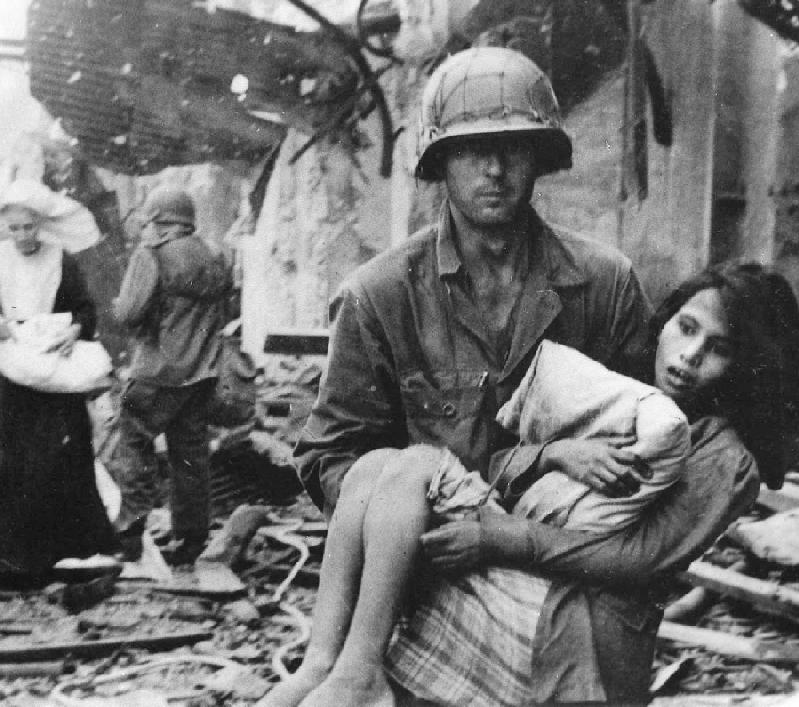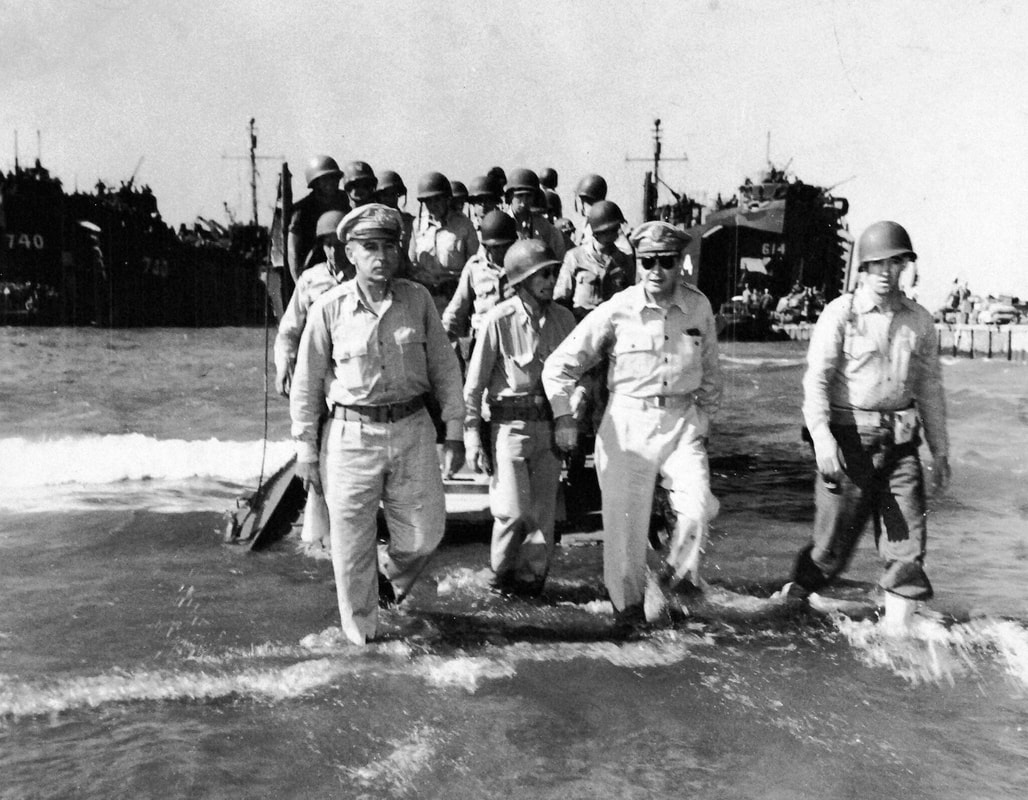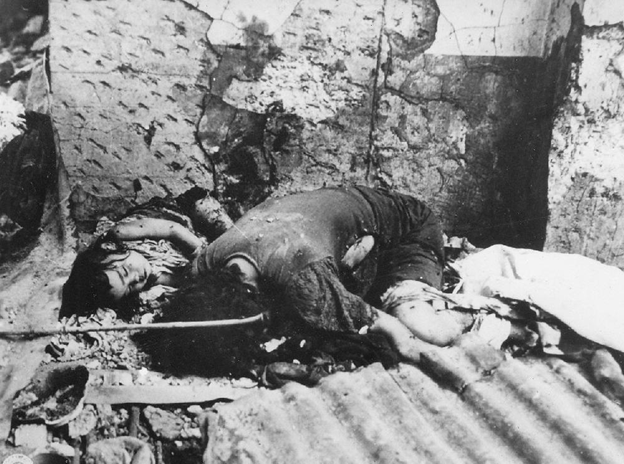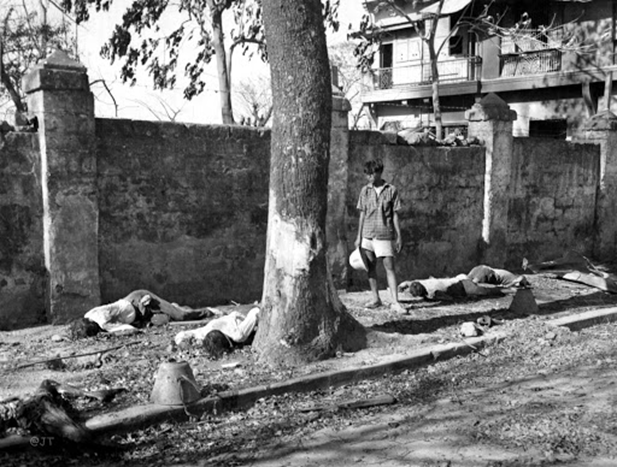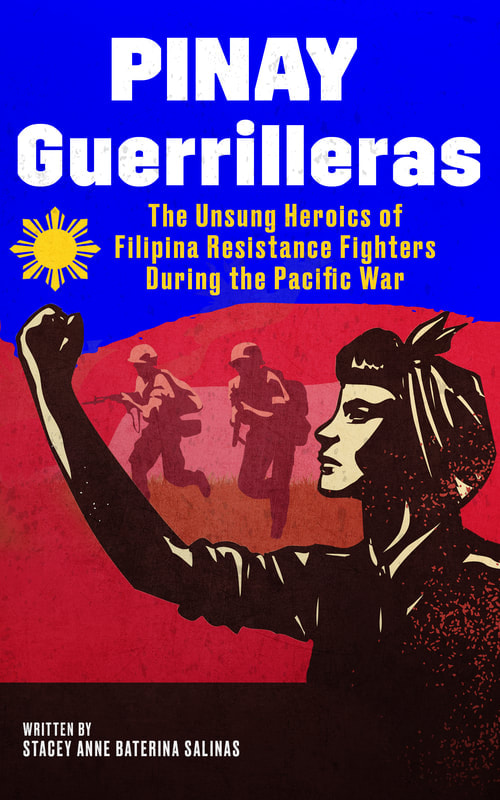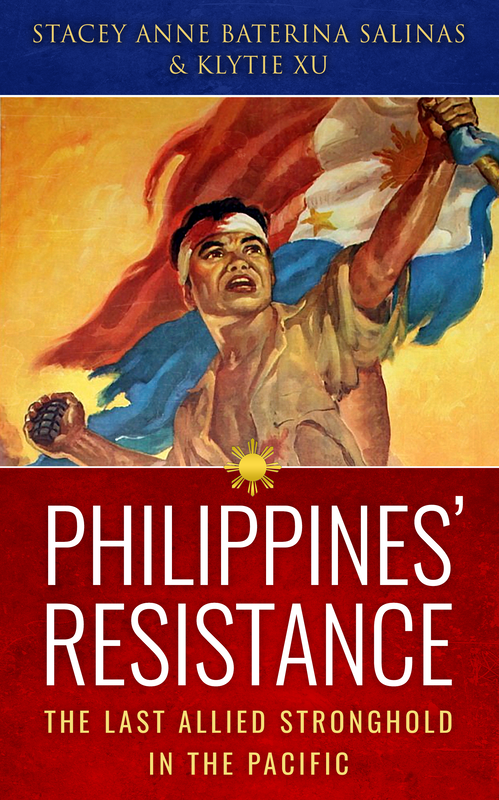|
Guest post by Tim Qiu, Instagram handle @asianww2addict While the Rape of Nanking in China is slowly making its way into mainstream media and educational systems, the Manila massacre is still struggling to get recognition regardless of the inexplicable inhumanity involved, matching even that of Nanking. The Japanese occupation of the Philippines' capital started after five months of fierce fighting against US forces during the early days of the Pacific War. Manila was declared an "open city" (undefended and exempt from enemy aggression) on December 26, 1941, by American General Douglas MacArthur, who vowed to return one day. His chance finally came on January 9, 1945, when MacArthur's 6th Army came ashore upon the beaches of Lingayen Bay to liberate the Philippines. While the Americans drew closer to the city largely unopposed, General and commander-in-chief of the Japanese Army, Tomoyuki "Tiger of Malaya" Yamashita, ordered the defenders to withdraw for an engagement elsewhere since he knew that he wouldn't be able to feed Manila's one million inhabitants. However, Rear Admiral Iwabuchi decided to ignore this request since he did not report to Army headquarters. He succeeded in convincing his staff to prepare a last-stand defense, one that would fight to the death. The first American units arrived on February 3, and a civilian internment camp converted from a university during the Japanese occupation was identified and liberated shortly afterward. MacArthur was getting increasingly arrogant about the initial gains in the city, and on the 6th, declared "Manila has fallen," was even preparing a victory parade. Unfortunately for him, the battle has barely begun. __ Almost immediately, his commanders reported stiffening and highly-concentrated resistance from the North and South of the city. It turned out that MacArthur and his men had only just reached Iwabuchi's heavily fortified positions supported by 17,000 soldiers who intended to fight to the last man. Japanese marines made the Americans fight for every inch of Manila, initiating one of the most intense urban warfare battles of the Second World War, comparable to the Battle of Berlin or Battle of Stalingrad. Manila had a very dense civilian population, and thousands of non-combatants were caught in the crossfire by the unrelenting artillery barrages, the numerous bombing raids, and merciless tank fire that would also reduce the "Pearl of the Orient" to mere ashes. The capital was deemed "the second most devastated city in World War II after Warsaw, Poland." By March 3, 1945, the last points of Japanese resistance in the city were suppressed, but not before they slaughtered at least 100,000 inhabitants in the most gruesome ways unimaginable. __ The atrocities began as the Americans completed their encirclement of Iwabuchi's garrison on February 12. There was little hope for the Japanese troops stationed in the city of a breakout, and consequently, they felt like taking down everyone in sight down with them, sparing nobody. Women of all ages were raped in public view, many of them brutally mutilated afterward. Japanese soldiers would even have intercourse with the dead. A large number of girls and women were forcefully recruited into military brothels, acting as "comfort women," and raped as much as 20 times in a single night. "Every time I was raped, I would just close my eyes and cry." Survivor of sexual slavery Rosa Henson recalled. Her father was skinned alive while tied upside down when he was unable to answer some questions from Japanese soldiers, and her mother was also raped. Her sisters had also become victims of sexual abuse in the "comfort stations," and one had multiple cigarette burns across her body. Countless civilians were stabbed to death with bayonets, very much resembling the situation in Nanking. Buildings were deliberately set on fire with people still inside. These buildings often bore no military significance, buildings such as apartments or shelters. This was not a "scorched earth tactic," but rather taking out one's frustration on innocents. Japanese marines would lob grenades into shelters and ditches, finishing any survivors with rifle shots and stabs from bayonets. On February 7, a psychiatric hospital was stormed, and 35 of its staff abducted. They were later killed with bayonets and pushed into the ocean off a cliff. People trying to escape the carnage in the city were mowed down by Japanese machine guns, and Filipinos were tricked into hiding as a large group in buildings only to be burnt alive or killed by explosives. Juan 'Johnny' Rocha, a survivor of the massacre, saw the bloodshed through his own eyes. He witnessed a man hanged from a telephone pole with a sign indicating that he was a 'thief.' His father lost 13 relatives torched alive, and Rocha also saw Japanese soldiers shoot a man for not raising his hands. He had another encounter with a woman screaming as she was being stabbed to death with a bayonet. They are the things that one does not forget. Even the Philippines Red Cross was not protected from harm. On February 10, Japanese soldiers charged into the building and proceeded to kill everyone in sight. Infants were pierced by bayonets like skewers with meat in front of their helpless mothers begging for mercy. The death toll was 65 Filipino patients, refugees, and staff members. Other horrific accounts included: "smashing the heads of babies against tree trunks," smearing gouged out eyeballs on walls for entertainment, and a school being burnt to the ground with machine-gun positions hunting down escapees. The Rape of Manila finally came to a halt when, on March 3, all of the remaining Japanese defenders had been eliminated. Rear Admiral Sanji Iwabuchi cowardly committed suicide towards the end of the battle, avoiding justice prosecution. The blame was then passed on to General Yamashita, who was hanged after being convicted. His hearing lasted 42 days. 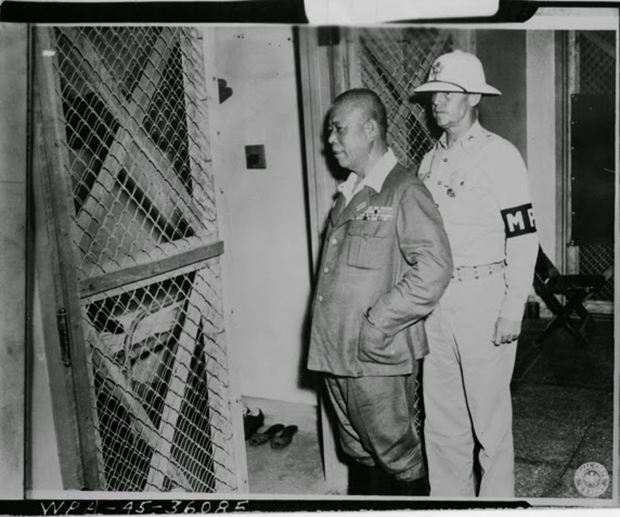 "The Tiger" returns to his "cage". Here General Tomoyuki Yamashita, guarded by military police, returns to his cell at the end of a day in court listening to testimony against him in the war crimes trial at Manila, P.I. His expression indicates his reaction to testimony submitted concerning massacre, rape, and other atrocities. 11/01/45 Sources: Wikipedia Commons Yamashita's innocence is greatly debated among historians since he was not personally present in Manila. In modern-day Japan, authors frequently write about the "heroism and determination" of the defenders but fail to recognize the true crime of the Japanese forces. SOURCES About the battle and massacre in general: https://pl.wikipedia.org/wiki/Masakra_w_Manili https://www.youtube.com/watch?v=ZBZjTbotmg0 Battle of Manila: https://en.wikipedia.org/wiki/Philippines_campaign_(1941%E2%80%9342) https://pl.wikipedia.org/wiki/Bitwa_o_Manil%C4%99_(1945) The massacre: https://globalnation.inquirer.net/99054/february-1945-the-rape-of-manila https://opinion.inquirer.net/127352/remembering-the-rape-of-manila Survivor’s stories: https://www.washingtonpost.com/world/asia_pacific/ill-keep-fighting-philippine-women-keep-alive-memory-of-sex-slave-horrors-during-world-war-ii/2019/05/27/e3135b98-674a-11e9-a698-2a8f808c9cfb_story.html https://www.washingtonpost.com/archive/politics/1994/10/27/50-years-later-survivors-of-battle-of-manila-speak-out/6ecc83ae-7580-4862-be13-c1496ba78a8f/ https://www.youtube.com/watch?v=cJ8boNQcnK8 https://www.dailymail.co.uk/news/article-2973493/American-survivors-remember-horrors-month-long-Battle-Manila-70-years-paying-tribute-100-000-civilians-killed-Japanese.html Yamashita’s prosecution : https://www.nytimes.com/1995/02/03/opinion/IHT-the-tiger-and-the-rape-of-manila.html More information on “comfort women”: https://en.wikipedia.org/wiki/Comfort_women https://www.youtube.com/watch?v=qsT97ax_Xb0&ab_channel=AsianBoss https://www.pbs.org/pov/watch/theapology/video-history-of-comfort-women/ To read more on the Philippines in World War 2, check out our publications:
4 Comments
Leooel
6/18/2021 03:25:50 pm
Well written!
Reply
Jack Sayers
10/14/2022 04:36:46 pm
My grandfather-in-law fought in a Filipino auxiliary unit. He was award a Bronze Star and two Purple Hearts. The sad thing is he was never given any type of compensation. No pay, no access to military hospitals in the P.I. and no funeral benefits. I think the US should have rewarded these brave men.
Reply
Jack
3/12/2023 09:43:06 am
Why should the US taxpayers reward Philippines Resistance fighters who were fighting against invaders of the Philippines ? The US Taxpayers aren't the world's sugar daddies. The Filipino resistance wasn't fighting invaders of the USA. They fought invaders of their home islands. Ridiculous how everyone expects US Taxpayers to finance their lives.
Reply
Dena Switzer
7/25/2023 09:49:04 pm
At the time of WWII, the Philippines had been apart of the Pacific Islands, which would have made them apart of the US. The Philippines was given after the war become their own country. How is it that when the government/people believe that no compensation should be given, the US military had a hand in destroying their country as much as the Japanese. How easy it is the say turn our backs on a people how had their lives played like pawns in a wargame. Many of the Resistance Fighters had families imprisoned in some of the worse POW camps ran by the Japanese. No country asks to be a pawn in anyones war. Soldiers come and go no matter whos doing the fighting. But the devastation that is left behind for a people who have nothing left. That some kind of help shouldn't have been given.....GeneralMacArthur went to Japan to start a food campaign to divert wheat from going to Korea to Japan to nourish the straving children in Japan. And yet where was the food for those children who starved to death while imprisoned during Japanese occupation.....please please please do your research about how these island people had their lives destoryed. Nobody is looking for a sugar daddy
Reply
Leave a Reply. |
- Home
- Stories
-
Internship
- Summer 2024 Internship
- Summer 2023 Internship
- Fall 2022 Internship
- Summer 2022 Internship
- Summer 2021 Internship
- Fall 2020- Spring 2021 Internship
- Summer 2020 Internship
- Fall 2019 Internship
- Summer 2019 Internship >
- School Year 2018-2019 Internship
- Summer 2018 Internship >
- Fall 2017 Internship
- Summer 2017 Internship >
- Books
- Archives
-
Resource Page
-
Supplementary Research Guides
>
- Unit 731 - Guide >
-
Philippines' Resistance - Guide
>
- Philippines World War II Timeline
- The Japanese Invasion & Conquest of the Philippines
- Bataan Death March
- Formation of Underground Philippines Resistance
- Supplies of the Guerrilla Fighters
- The Hukbalahap
- Hunter's ROTC
- Marking's Guerrillas
- United States Army Forces in the Philippines of Northern Luzon (USAFIP-NL)
- The Aetas
- Chinese and Filipino-Chinese Nationalist Guerrilla Units
- The Female Faces of the Philippine Guerrillas
- Rising Sun Flag - Guide >
- Pinay Guerrilleras - Guide >
- Fall of Singapore - Guide >
- Three Years and Eight Months - Guide >
- Siamese Sovereignty - Guide >
- The Khabarovsk War Crimes Trial - Guide >
- Unit 731 Cover-up : The Operation Paperclip of the East - Guide >
- Marutas of Unit 731 - Guide >
- Prince Konoe Memoir - Guide >
- Competing Empires in Burma - Guide >
- Battle of Shanghai - Guide >
- Ishi Shiro - Guide >
- Taiwan The Israel of the East - Guide >
- Seeking Justice for Biological Warfare Victims of Unit 731 - Guide >
- Rice and Revolution - Guide >
- Clash of Empires - Guide >
-
Hunger for Power and Self-SufficiencyI - Guide
>
- The Influence of War Rations on Post-War Culinary Transformations
- How World War II Complicated Food Scarcity and Invention
- American Military Innovations
- Government-Sponsored Food Inventions in Europe during World War II
- Feeding the Army: The Adaptation of Japanese Military Cuisine and Its Impact on the Philippines
- Mixed Dishes: Culinary Innovations Driven by Necessity and Food Scarcity
-
Denial A Quick Look of History of Comfort Women and Present Days’ Complication - Guide
>
- The Comfort Women System and the Fight for Recognition
- The Role of Activism and International Pressure
- The Controversy over Japanese History Textbooks
- The Sonyŏsang Statue and the Symbolism of Public Memorials
- Activism and Support from Japanese Citizens
- The Future of Comfort Women Memorials and Education
- Echoes of Empire: The Power of Japanese Propaganda - Guide >
- Lesson Plans >
-
Supplementary Research Guides
>
|
Pacific Atrocities Education
730 Commercial Street San Francisco, CA 94108 415-988-9889 |
Copyright © 2021 Pacific Atrocities Education.
We are a registered 501 (c)(3) charity. |
- Home
- Stories
-
Internship
- Summer 2024 Internship
- Summer 2023 Internship
- Fall 2022 Internship
- Summer 2022 Internship
- Summer 2021 Internship
- Fall 2020- Spring 2021 Internship
- Summer 2020 Internship
- Fall 2019 Internship
- Summer 2019 Internship >
- School Year 2018-2019 Internship
- Summer 2018 Internship >
- Fall 2017 Internship
- Summer 2017 Internship >
- Books
- Archives
-
Resource Page
-
Supplementary Research Guides
>
- Unit 731 - Guide >
-
Philippines' Resistance - Guide
>
- Philippines World War II Timeline
- The Japanese Invasion & Conquest of the Philippines
- Bataan Death March
- Formation of Underground Philippines Resistance
- Supplies of the Guerrilla Fighters
- The Hukbalahap
- Hunter's ROTC
- Marking's Guerrillas
- United States Army Forces in the Philippines of Northern Luzon (USAFIP-NL)
- The Aetas
- Chinese and Filipino-Chinese Nationalist Guerrilla Units
- The Female Faces of the Philippine Guerrillas
- Rising Sun Flag - Guide >
- Pinay Guerrilleras - Guide >
- Fall of Singapore - Guide >
- Three Years and Eight Months - Guide >
- Siamese Sovereignty - Guide >
- The Khabarovsk War Crimes Trial - Guide >
- Unit 731 Cover-up : The Operation Paperclip of the East - Guide >
- Marutas of Unit 731 - Guide >
- Prince Konoe Memoir - Guide >
- Competing Empires in Burma - Guide >
- Battle of Shanghai - Guide >
- Ishi Shiro - Guide >
- Taiwan The Israel of the East - Guide >
- Seeking Justice for Biological Warfare Victims of Unit 731 - Guide >
- Rice and Revolution - Guide >
- Clash of Empires - Guide >
-
Hunger for Power and Self-SufficiencyI - Guide
>
- The Influence of War Rations on Post-War Culinary Transformations
- How World War II Complicated Food Scarcity and Invention
- American Military Innovations
- Government-Sponsored Food Inventions in Europe during World War II
- Feeding the Army: The Adaptation of Japanese Military Cuisine and Its Impact on the Philippines
- Mixed Dishes: Culinary Innovations Driven by Necessity and Food Scarcity
-
Denial A Quick Look of History of Comfort Women and Present Days’ Complication - Guide
>
- The Comfort Women System and the Fight for Recognition
- The Role of Activism and International Pressure
- The Controversy over Japanese History Textbooks
- The Sonyŏsang Statue and the Symbolism of Public Memorials
- Activism and Support from Japanese Citizens
- The Future of Comfort Women Memorials and Education
- Echoes of Empire: The Power of Japanese Propaganda - Guide >
- Lesson Plans >
-
Supplementary Research Guides
>
